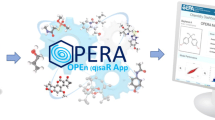Abstract
A rather small data matrix of seven chemicals and 17 different ecotoxicological end points is examined by methods of Discrete Mathematics. Especially, the lattice theory and its variant, the Formal Concept Analysis may be an attractive tool to analyze Quantitative Structure Activity Relationships, when a numerical functional approach is not at hand. The central item is the so called concept, which is a pair of subsets: A subset of molecules and a subset of properties which correspond to each other. The concepts are partially ordered due to a subset relation. From this subset relation, if–then-rules are derived, which aim to relate the structure of molecules with their ecotoxicological properties. For example, the following chemical rule is found: Cl ⇒ (2A,2C,2M). That means, all substances considered here having a “–Cl” as structural code have a medium ecotoxicological effect on Daphnia magna , Orconectes immunisare (Crustacea) and on Photobacterium phosphoreum , at least within the training set.
Similar content being viewed by others
References
Bartel, H.-G. (1996). Mathematische Methoden in der Chemie . Heidelberg, Beslini, Oxford: Spektrum.
Bartel, H.-G. and Brüggemann, R. (1998). Application of formal concept analysis to structure-activity relationships. Fresenius J. Anal. Chem. 361 , 23–8.
Birkhoff, G. (1984). Lattice Theory . Vol. 25. Providence, Rhode Island: American Mathematical Society.
Brüggemann, R., Pudenz, S., Carlsen, L., Sørensen, P.B., Thomson, M. and Mishra, R.K. (2000). The use of Hasse diagrams as a potential approach for inverse QSAR. SAR QSAR Environ. Res. 11 (5–6), 1–15.
Brüggemann, R., Pudenz, S. and Bartel, H.-G. (1999). Rule generation by means of lattice theory. In G.C. Gini and A.R. Katritzky (eds). Predictive Toxicology of Chemicals: Experiences and Impact of AI Tools . Papers from the 1999 AAAI Symposium, Menlo Park. California: AAAI Press.
Brüggemann, R., Voigt, K. and Steinberg, C. (1997). Application of formal concept analysis to evaluate environmental databases. Chemosphere 35 , 479–86.
Brüggemann, R. and Bartel, H.-G. (1999). A theoretical concept to rank environmentally significant chemicals. J. Chem. Inform. Comput. Sci. 39 , 211–7.
Carlsen, L., Sørensen, P.B. and Thomsen, M. (2000). Estimation of octanol-water distribution coefficients—using partial order technique. In P.B. Sørensen, L. Carlsen, B.B. Mogensen, R. Brüggemann, B. Luther, S. Pudenz, U. Simon, E. Halfon, T. Bittner, K. Voigt, G. Welzl and F. Rediske (eds). Order Theoretical Tools in Environmental Sciences, Proceedings of the Second Workshop, 21 October 1999, Roskilde, Denmark . pp. 105–15. Roskilde: National Environmental Research Institute.
Davey, B.A. and Priestley, H.A. (1990). Introduction to Lattices and Order . Cambridge: Cambridge University Press.
Devillers, J., Thioulouse, J. and Karcher, W. (1993). Chemometrical evaluation of multispecies-multichemical data by means of graphical techniques combined with multivariate analyses. Ecotoxicol. Environ. Safety 26 , 333–45.
Ganter, B. and Wille, R. (eds) (1996). Formale Begriffsanalyse—Mathematische Grundlagen. Berlin: Springer-Verlag.
Gasteiger, J. and Zupan, J. (1993). Neural networks in chemistry. Angewa. Chemie. Int. Ed. Engl. 32 , 503–27.
Kearsley, S.K., Sallamack, S., Fluder, E.F., Andose, J.D., Mosley, R.T. and Sheridan, R.P. (1996). Chemical similarity using physicochemical property descriptors. J. Chem. Inform. Comput. Sci. 36 , 118–27.
Kubinyi, H. (1993). QSAR: Hansch Analysis and Related Approaches, Methods and Principles in Medicinal Chemistry . Weinheim: VCH-Verlagsgesellschaft.
Simon, V., Gasteiger, J. and Zupan, J. (1993). A combined application of two different neural network types for the prediction of chemical reactivity. J. Am. Chem. Soc. 115 , 9148–59.
Welzl, G., Voigt, K. and Rediske, G. (1999). Visualisation of environmental pollution—Hasse diagram technique and explorative statistical methods. In R. Brüggemann, J. Grell, U. Simon and S. Pudenz (eds). Proceedings of the Workshop on Order Theoretical Tools in Environmental Sciences , 16 November 1998. Berlin: Berichte des IGB, Heft 6, Sonderheft 1.
Author information
Authors and Affiliations
Corresponding author
Rights and permissions
About this article
Cite this article
Pudenz, S., Brüggemann, R. & Bartel, HG. QSAR of Ecotoxicological Data on the Basis of Data-Driven If-Then-Rules. Ecotoxicology 11, 337–342 (2002). https://doi.org/10.1023/A:1020501204807
Issue Date:
DOI: https://doi.org/10.1023/A:1020501204807



